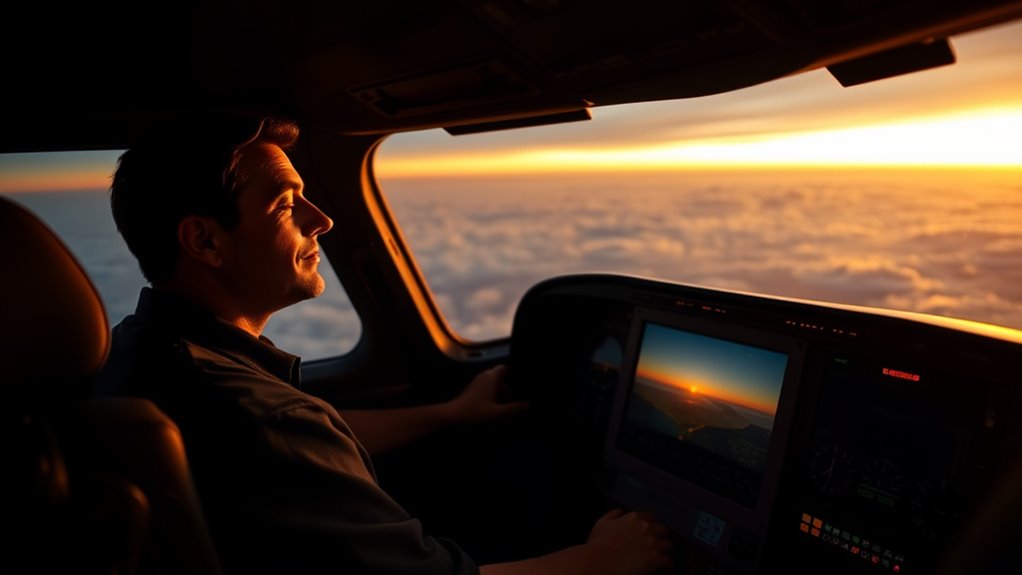Mindfulness can significantly enhance your performance as a pilot by improving focus, reducing stress, and sharpening decision-making skills in high-pressure situations. Simple techniques like deep breathing and grounding meditations can help you manage anxiety before flights and maintain emotional regulation in the cockpit. Incorporating mindfulness into your routine not only boosts job satisfaction but also enhances communication with crew members. Discover how these practices can be integrated into your daily life and training for even greater benefits.
Key Takeaways
- Mindfulness enhances focus and decision-making, crucial for pilots managing high-pressure situations during flights.
- Techniques like deep breathing and body scans help reduce pre-flight anxiety and maintain alertness.
- Structured mindfulness practices can be integrated into pilot training and daily routines for improved emotional regulation.
- Regular mindfulness practices contribute to better communication and teamwork among crew members, enhancing safety.
- Evidence shows that mindfulness can lower stress levels and improve overall pilot performance and well-being.
Benefits of Mindfulness for Pilots
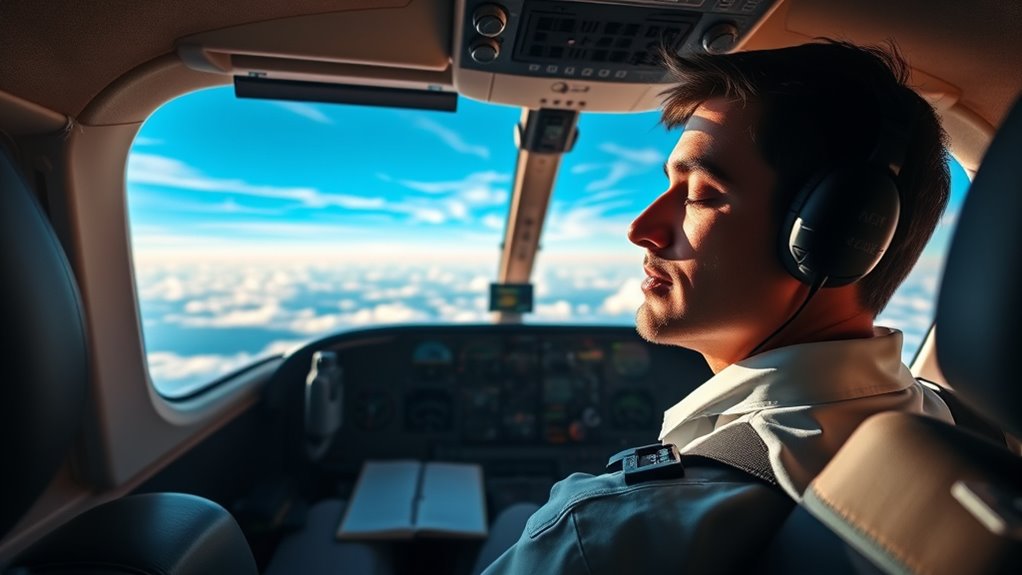
When you incorporate mindfulness into your routine, you can experience a range of benefits that enhance your performance as a pilot. Improved focus and attention become second nature, helping you process critical information more effectively, even during distractions.
Mindfulness sharpens your decision-making skills, allowing you to assess situations calmly and act decisively under pressure. You’ll find stress reduction through meditation activates your relaxation response, keeping you calm during turbulence.
Mindfulness enhances decision-making, enabling calm assessments and decisive actions even in high-pressure situations.
Better sleep quality means you’ll be well-rested despite irregular schedules. Additionally, mindfulness equips you with tools for emotional regulation, improving communication and teamwork in the cockpit.
All these benefits contribute significantly to your overall performance and well-being as a pilot, making mindfulness an invaluable part of your routine.
Mindfulness Techniques for Pilots
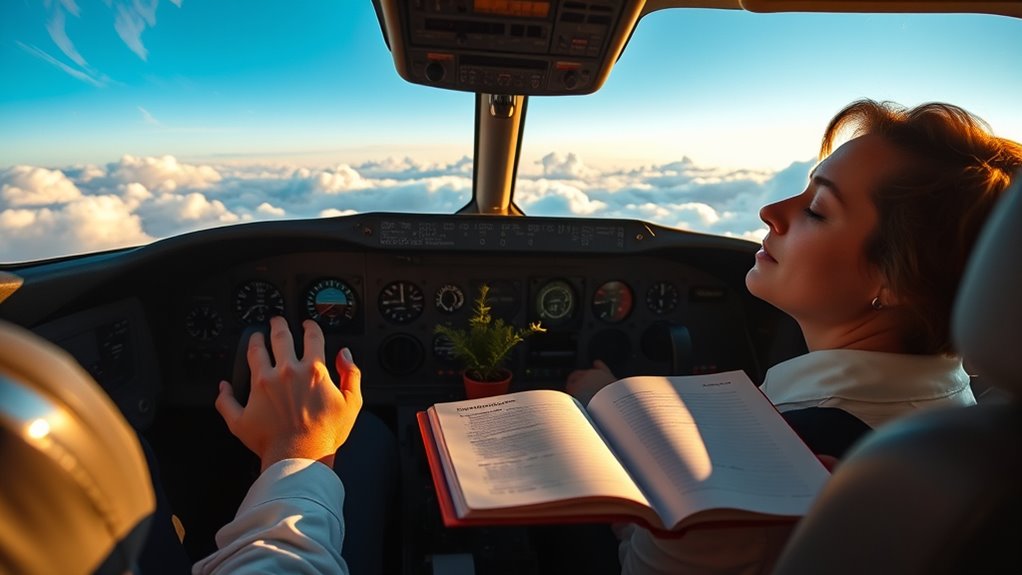
Incorporating mindfulness techniques into your routine as a pilot can further amplify the benefits you’ve already experienced.
Start with a pre-flight grounding meditation, visualizing roots growing from your feet to help you feel centered. Deep breathing exercises can ease pre-flight anxiety, while mindful observation of an object enhances focus.
During the flight, continue deep belly breathing to manage stress and turbulence. Use a modified body scan to release tension while staying alert.
After landing, practice a thorough body scan meditation and reflect on your flight to recognize successes. Engaging in self-care activities like yoga promotes recovery.
Impact of Stress on Pilots
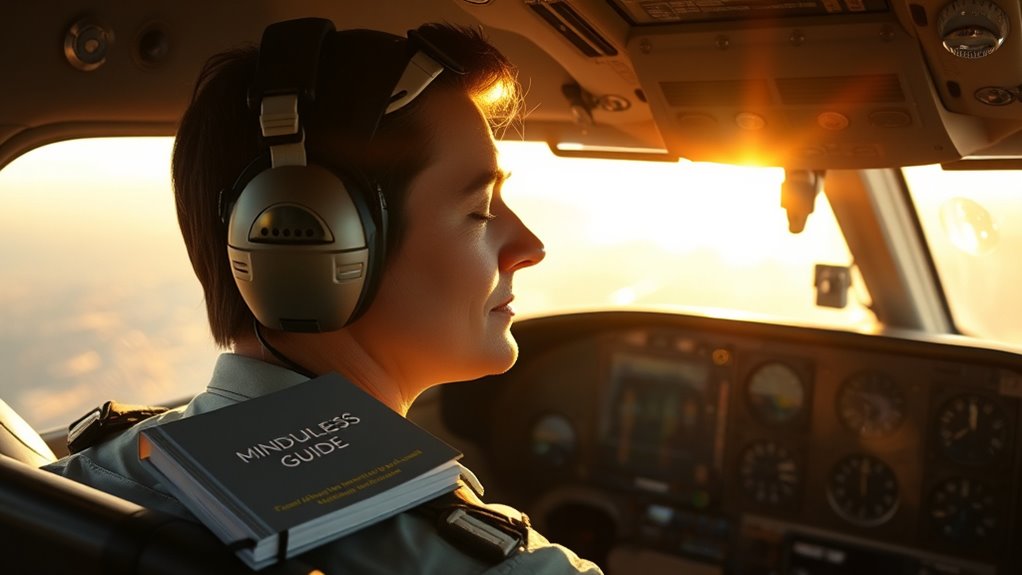
Stress significantly impacts pilots, affecting their performance and well-being. Environmental stressors like noise and cramped cockpits, along with physiological factors such as fatigue and anxiety, can overwhelm you.
Operational pressures from demanding schedules and irregular hours further heighten stress levels. As stress mounts, you may experience impaired working memory, reduced situational awareness, and slower decision-making, all of which jeopardize safety.
Operational pressures and irregular hours elevate stress, impairing memory and decision-making, ultimately threatening safety in aviation.
Physically, stress manifests as increased heart rate and sleep disturbances, leading to burnout and health issues. Furthermore, stress can strain crew dynamics, complicating communication and teamwork.
The aviation industry recognizes these challenges, highlighting the urgent need for better support systems and mental health resources to help you manage stress effectively and maintain optimal performance. Additionally, understanding the stages of good grief can provide valuable insights into processing stress and emotional challenges in high-pressure environments.
Integrating Mindfulness Into Training
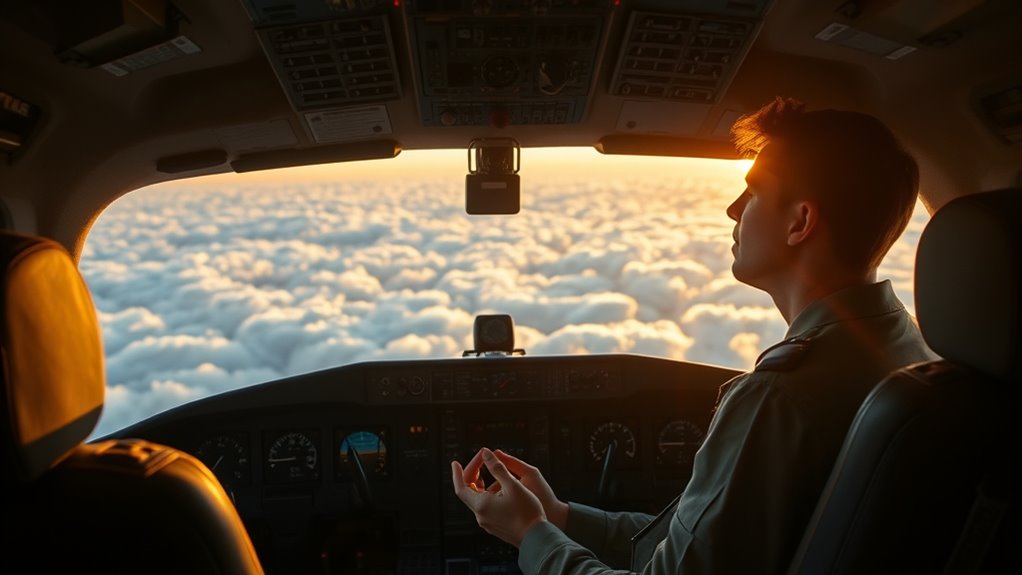
Mindfulness can be a game-changer in pilot training, offering practical tools to enhance focus and decision-making. By incorporating structured mindfulness practices, like breathing techniques and body scans, into your training curriculum, you can develop essential skills.
Establishing daily routines, even during layovers, helps reinforce these practices. Utilizing meditation apps like Headspace or Calm allows you to fit guided meditations into your busy schedule.
Classroom environments can also teach mindfulness during operational tasks, creating a holistic training approach. This combination of mindfulness and technical training promotes improved focus, better decision-making, and effective emotional regulation, making you a more capable and resilient pilot.
Embracing mindfulness isn’t just beneficial; it’s vital for navigating the complexities of modern aviation.
Real-World Applications of Mindfulness
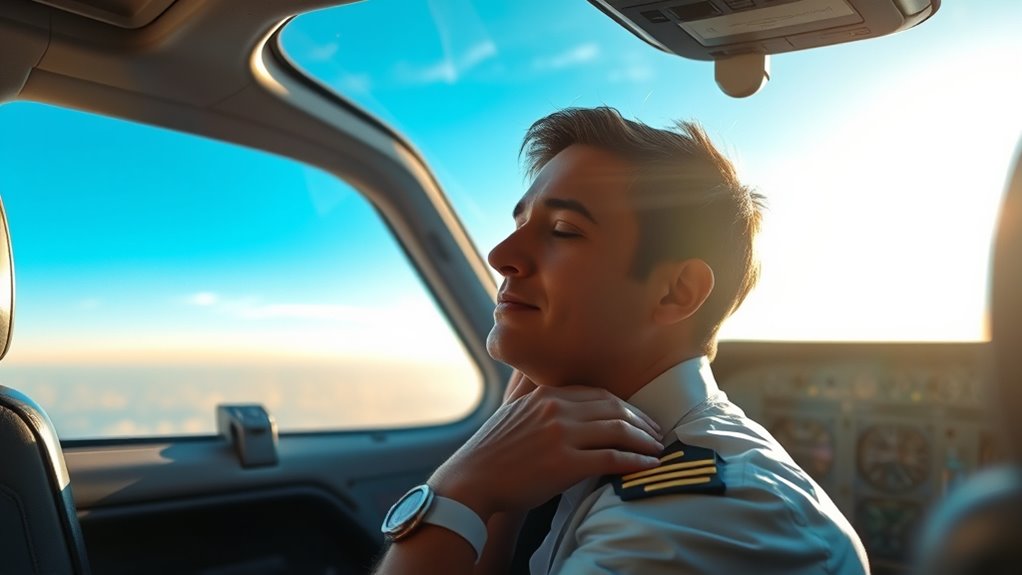
Although the aviation industry faces unique challenges, the real-world applications of mindfulness can significantly enhance pilot performance and safety.
Airlines like Cathay Pacific are already offering mindfulness programs to help you manage stress and improve sleep quality. Despite some cultural resistance, studies show that mindful pilots experience fewer hazardous incidents due to better risk perception and decision-making.
Resources like Mindful Aviator provide confidential support, while workshops focus on enhancing risk assessment skills. As pilots engage in mindfulness practices, they also learn to protect their energy amidst the chaotic demands of flying.
With meditation apps like Headspace and Calm, you can easily integrate mindfulness into your busy schedule.
As more airlines adopt these practices, mindfulness may become a standard part of aviation culture, promoting a safer and more supportive environment for everyone involved.
Mindfulness and Performance
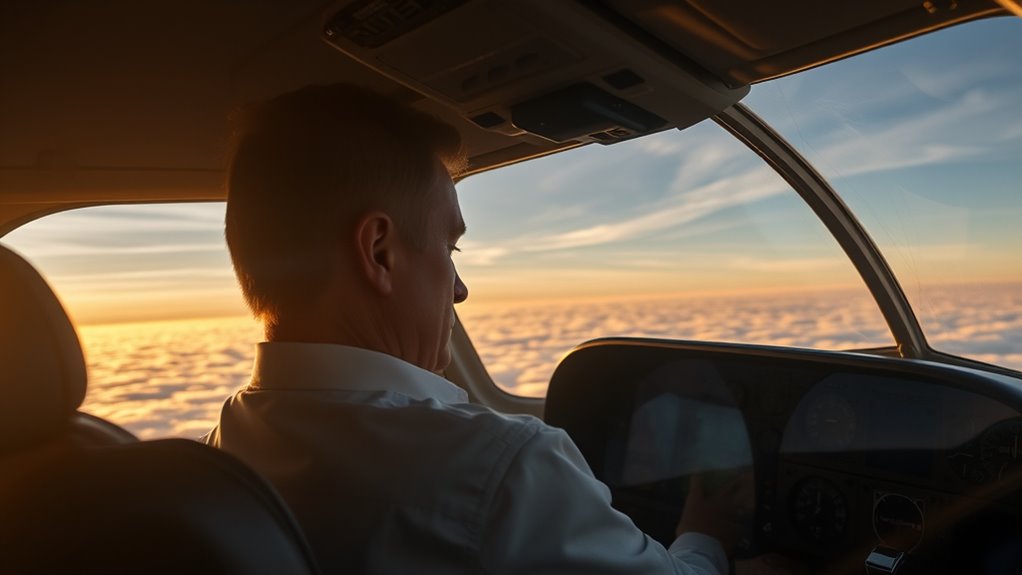
When you incorporate mindfulness into your routine, you enhance not just your focus but also your overall performance as a pilot.
Mindfulness strengthens your attention span, making you less susceptible to distractions during critical moments. It increases your situational awareness, allowing you to stay attuned to your surroundings.
By recognizing when your mind wanders, you can return to the present, improving task management and productivity. Moreover, mindfulness fosters calmer decision-making, reducing impulsive reactions and enhancing your risk perception.
This leads to better judgments and crisis management, ultimately lowering your error rate. With mindfulness, you not only perform better but also contribute to safer flight operations, ensuring a more efficient and secure experience in the cockpit.
Overcoming Challenges in Mindfulness Adoption
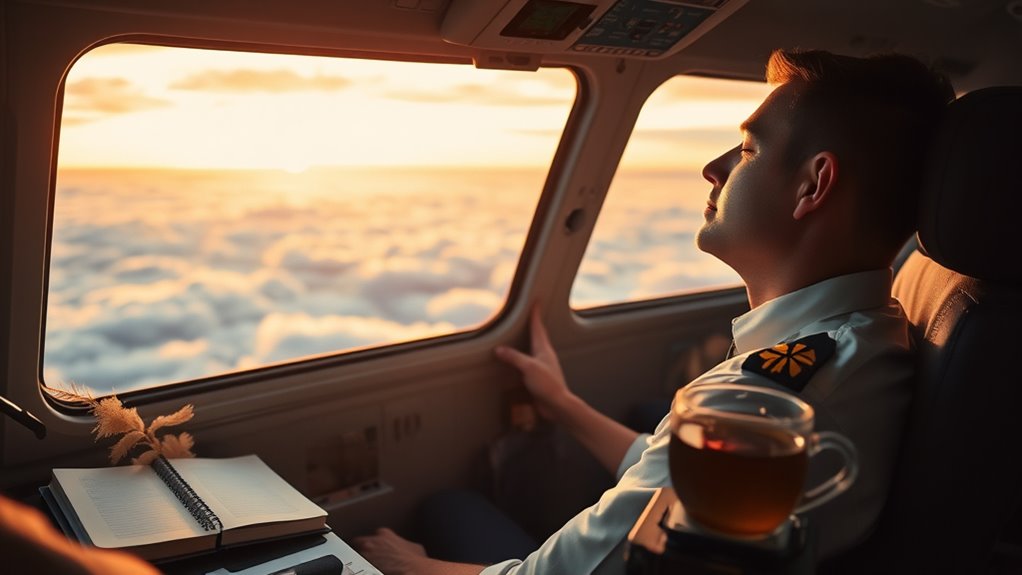
Pilots can significantly enhance their performance through mindfulness, but adopting these practices comes with its own set of challenges.
Cultural resistance and stigma around mental health can make it tough to embrace mindfulness in aviation. You might find limited downtime due to demanding schedules, making it hard to establish a routine.
Additionally, the lack of aviation-specific research can leave you skeptical about mindfulness’s effectiveness. Integrating mindfulness into training programs requires careful planning and resources, while ensuring the tools used are accessible and culturally sensitive.
Collaborating with aviation authorities is crucial to promote widespread adoption. By addressing these challenges head-on, you can pave the way for a more mindful approach to flying, enhancing both your performance and well-being.
Future Directions for Mindfulness in Aviation
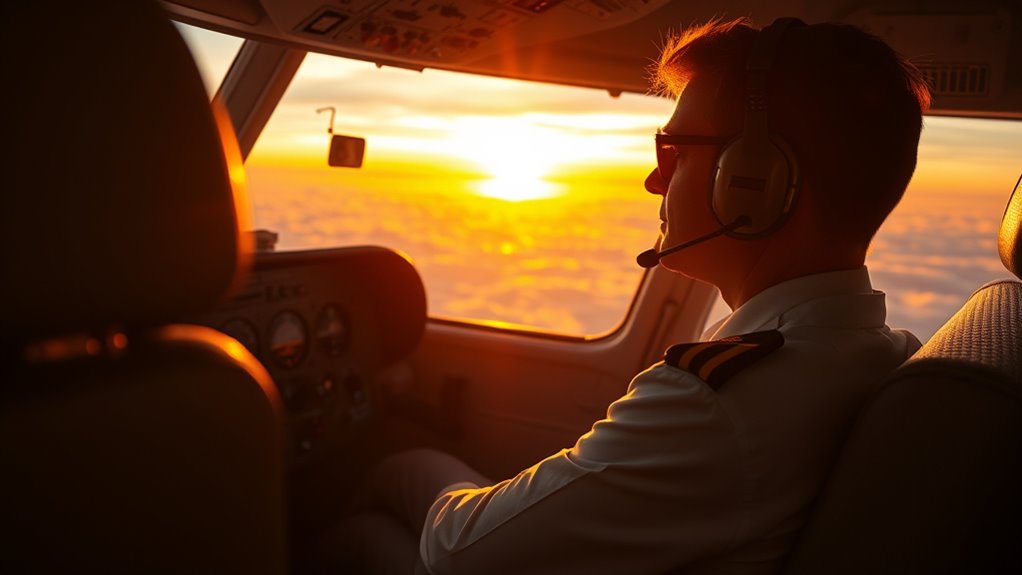
As the aviation industry continues to evolve, integrating mindfulness practices into pilot training and operations presents a promising path forward.
You can expect mindfulness techniques, like breathing exercises and meditation, to become standard in training programs, enhancing focus and decision-making.
Structured programs, such as Australia’s Diploma of Aviation, are already incorporating these practices.
With evidence-based research underway, collaboration with aviation academies will tailor mindfulness to pilots’ unique demands.
This approach not only reduces stress and human error but also fosters better communication in high-pressure situations.
As airlines adopt mindfulness into their wellness initiatives, the future holds potential for improved pilot performance and aviation safety, ultimately benefiting everyone in the industry.
Frequently Asked Questions
How Long Should Mindfulness Practices Be for Pilots?
Mindfulness practices can be effective in short sessions of just 2-5 minutes, making them easy to fit into your busy schedule.
If you’re consistent and practice daily, you’ll build resilience and mental clarity over time.
Once you establish a habit, gradually increase the duration by another 2-5 minutes.
You might even find that quick mindfulness exercises before or after tasks help you feel more centered and relaxed throughout your day.
Can Mindfulness Improve Safety Records in Aviation?
Absolutely, mindfulness can improve safety records in aviation.
By enhancing your focus and awareness, you’re better equipped to perceive risks and make sound decisions during critical situations. Mindfulness reduces stress, helping you remain calm and composed, which leads to fewer errors.
Furthermore, it fosters better communication and teamwork among crew members, creating a safer environment.
Integrating mindfulness practices into your routine could significantly contribute to overall aviation safety and performance.
Are There Specific Mindfulness Apps Recommended for Pilots?
While you might think meditation apps are just for relaxation, they can significantly enhance your focus and stress management.
Apps like Headspace and Calm offer tailored sessions that help you stay present and reduce anxiety.
The Healthy Minds Program provides valuable insights into awareness and purpose, while Mindfulaviator.com focuses specifically on your needs as a pilot.
Embracing these tools can elevate your mental game and improve overall performance in high-pressure situations.
What Are the Costs Associated With Mindfulness Training for Airlines?
When considering the costs associated with mindfulness training for airlines, you’ll need to factor in several elements.
Training development can be expensive, especially for curriculum design and instructor fees. You’ll also face costs for facilities and materials.
Additionally, time away from duty can impact operational capacity, requiring staffing adjustments. Regular training sessions may increase ongoing expenses, but the potential for reduced errors and improved mental health could lead to long-term savings.
How Can Pilots Measure the Effectiveness of Mindfulness Practices?
To measure the effectiveness of mindfulness practices, you can use various tools. Start with questionnaires like the Mindful Attention Awareness Scale to assess your trait mindfulness.
Track your emotional regulation and stress levels before and after mindfulness sessions. Monitor incident reports and performance metrics to see if there’s an improvement in attention and communication.
Gathering qualitative feedback from your own experiences can also provide valuable insights into how mindfulness impacts your overall well-being and performance.
Conclusion
In the high-stakes world of aviation, mindfulness isn’t just a tool—it’s a lifeline. By embracing mindfulness practices, you can navigate the turbulent skies of stress and uncertainty with clarity and focus. Imagine yourself in the cockpit, calm and centered, making split-second decisions with confidence. As you integrate these techniques into your routine, you’ll not only enhance your performance but also foster a healthier mindset. The sky’s the limit when you prioritize mindfulness in your aviation journey.

